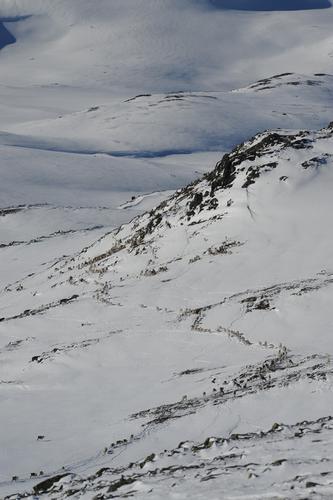当前位置:
X-MOL 学术
›
J. Appl. Ecol.
›
论文详情
Our official English website, www.x-mol.net, welcomes your feedback! (Note: you will need to create a separate account there.)
The last moves: The effect of hunting and culling on the risk of disease spread from a population of reindeer
Journal of Applied Ecology ( IF 5.7 ) Pub Date : 2020-09-10 , DOI: 10.1111/1365-2664.13761 Atle Mysterud 1 , Geir Rune Rauset 2 , Bram Van Moorter 2 , Roy Andersen 2 , Olav Strand 2 , Inger Maren Rivrud 3
中文翻译:

最后一步:狩猎和扑杀对驯鹿种群传播疾病的风险的影响
更新日期:2020-09-10
Journal of Applied Ecology ( IF 5.7 ) Pub Date : 2020-09-10 , DOI: 10.1111/1365-2664.13761 Atle Mysterud 1 , Geir Rune Rauset 2 , Bram Van Moorter 2 , Roy Andersen 2 , Olav Strand 2 , Inger Maren Rivrud 3
Affiliation

|
- Hunting and culling are frequently used to combat infectious wildlife diseases. The aim is to markedly lower population density in order to limit disease transmission or to eradicate the host. Massive host culling can yield a trade‐off when combating wildlife disease; it follows that intrusive actions may have unintended behavioural side effects, leading to the geographic spread of disease. The manner in which such excessive hunting and culling of hosts can affect the movement and dispersion of cervids has not been studied.
- In this study, we quantified the behaviour (daily movements and habitat use) and dispersion of GPS‐marked reindeer (n = 24) before and during the eradication of an entire population (>2,000 reindeer) infected with chronic wasting disease (CWD) in Norway. We compared behaviour and dispersion during 10 ordinary hunting seasons (2007–2016), an extended hunting season (2017) and marksmen culling (2017/2018).
- Seasonality had a major impact on movements. Reindeer movements during the early hunting season (20 August–20 September) did not increase the overall movements compared to that in the pre‐hunt season (20 July–19 August), while extended hunting into October (as in 2017) and marksmen culling from November to February markedly increased daytime movements relative to that normally observed in this time of the year. Towards the end of the eradication, the remaining reindeer sought refuge at restricted high‐elevation areas with limited forage production. Reindeer used novel areas towards the perimeter of the range, but active herding during culling stopped one herd from leaving the CWD zone.
- Synthesis and applications. With emerging wildlife diseases, host culling is becoming a more frequently used tool for managers in Europe. Our study highlights the potential trade‐off between combating disease transmission within a population and the risk of geographic spread. Such insight is important to design mitigation measures, such as perimeter fencing or herding, to avoid the risk of the geographic spread of disease in cases of severe and economically important wildlife diseases.
中文翻译:

最后一步:狩猎和扑杀对驯鹿种群传播疾病的风险的影响
- 狩猎和扑杀经常被用来与野生动植物传染病作斗争。目的是显着降低种群密度,以限制疾病传播或根除宿主。在与野生动物疾病作斗争时,大规模的寄主选择可能会产生取舍。因此,侵入性行为可能会产生意想不到的行为副作用,从而导致疾病的地理传播。尚未研究这种过度捕杀宿主的方法会影响子宫颈的运动和分散的方式。
- 在这项研究中,我们量化了 在消灭感染了慢性消耗性疾病(CWD)的整个人群(> 2,000头驯鹿)之前和期间,GPS标记的驯鹿(n = 24)的行为(日常活动和栖息地使用)和散布。挪威。我们比较了10个普通狩猎季节(2007-2016年),延长狩猎季节(2017年)和神枪手淘汰(2017/2018年)期间的行为和散布。
- 季节性对运动产生重大影响。与狩猎前季节(7月20日至8月19日)相比,早期狩猎季节(8月20日至9月20日)的驯鹿运动并未增加总体运动,而延长狩猎至10月(如2017年)和神枪手的扑杀相对于一年中这个时候通常观察到的白天运动,从十一月到二月的白天运动明显增加。铲除工作即将结束时,剩下的驯鹿在草场产量有限的受限高海拔地区寻求庇护。驯鹿在该范围的周边使用了新颖的区域,但在淘汰期间进行主动放牧阻止了一个放牧群离开CWD区。
- 综合与应用。随着新出现的野生动物疾病,寄宿家庭淘汰已成为欧洲管理人员越来越常用的工具。我们的研究强调了在人口中与疾病传播作斗争与地理扩散风险之间的潜在权衡。这种洞察力对于设计缓解措施(如围墙围栏或放牧)非常重要,可以避免在严重且经济上很重要的野生动植物疾病的情况下疾病在地理上扩散的风险。


























 京公网安备 11010802027423号
京公网安备 11010802027423号